Home
> Chords
/ Theory
> Root Notes
Root notes are the notes upon which a chord is built. It is literally the root of the chord.
The root note is often labelled 1.
This is because it marks the first note in the scale
around which the chord is built.
All the other tones in the chord are intervals in relation to this root note.
All my chord diagrams clearly mark the root note as a red 1!
The root note provides the first building block for a given chord. Whichever note the root lies on is the note around which the chord is notated.
For example, if the root note is G, and the chord built on this root note is a major chord, the chord will be G major.
If the root note is C# (C sharp), and the chord built on this root note is a minor chord, the chord will be C# minor.
If the root note is Eb (E flat), and the chord built on this root note is a major 7th chord, the chord will be Ebmaj7.
So that's the first thing to understand about chord root notes - the root note is what determines the letter we use in the chord symbol.
If I asked you what the root note of Esus4 (E suspended 4th) is, what would your answer be?
E is correct!
Whichever letter you see used in a chord is the note you first look for on the fretboard in order to build the rest of the chord from that position. That's just one reason why you should learn to be able to identify chord root notes on the fretboard.
If we wanted to play a C major chord, we'd first locate the note C in various positions across the fretboard. We start with the bottom 3 strings, E, A and D in standard tuning, because these strings most commonly provide the lowest root note (or bass root) of a given chord.
However, if you've learned the notes on the fretboard, you'll know where the note C occurs on all 6 strings...

Most chord shapes are built upon an E, A or D string root note. We can call this the "bass note" of our chord. If you're playing with a bassist, you wouldn't have to actually play the bass root note, but it's good to know where it is for a visual reference point, to find your bearings on the fretboard.
Using the C root note at the 8th fret on the low E string, I could build a standard barre chord shape on that position...
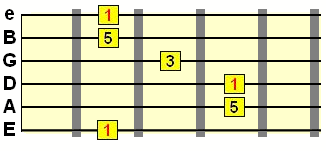
Fret 8
Now, you'll notice that there are higher chord root notes on the D and high E strings. These are also the note C, each one an octave of the last.
Another option for building a C major chord would be on the A string root note we identified, at the 3rd fret...
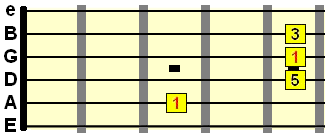
Yet another option would be the open C major form, again rooted at the 3rd fret (C)...
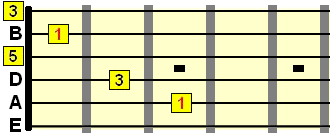
So by being able to identify bass root notes like this, we have several positions for building different voicings of the same chord. Not just major or minor chords either - there are whole host of chord types we can build on this root note. More on these variations in the chords section.
Also, don't forget that the open E, A and D strings provide bass root notes for open chord fingerings. For example, the open E minor chord uses the open low E string as its bass root note...
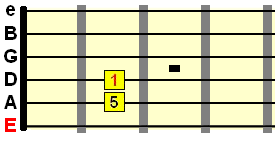
From this root note, you can modify and add to the other tones in the chord as you wish, but the root note is always the central tonal reference point for any chord you build.
As mentioned earlier, you don't actually have to play the root note, but just knowing where it is gives you that visual reference point for stacking the rest of the chord.
Once you fully understand this root note concept, you're ready to move on to learning how chord tones (intervals) are stacked in relation to that root note.
Learn Guitar Chords
Guitar Theory Lessons
Guitar Chord Root Notes
Understanding chord root notes is crucial, not only if you're planning on delving deeper into chord theory, but also if you want to be able to build chords in any key.Root notes are the notes upon which a chord is built. It is literally the root of the chord.
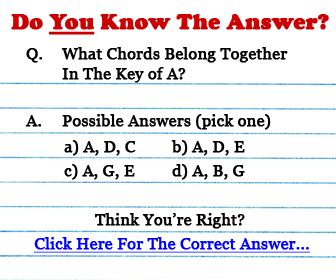 |
All the other tones in the chord are intervals in relation to this root note.
All my chord diagrams clearly mark the root note as a red 1!
The root note provides the first building block for a given chord. Whichever note the root lies on is the note around which the chord is notated.
For example, if the root note is G, and the chord built on this root note is a major chord, the chord will be G major.
If the root note is C# (C sharp), and the chord built on this root note is a minor chord, the chord will be C# minor.
If the root note is Eb (E flat), and the chord built on this root note is a major 7th chord, the chord will be Ebmaj7.
So that's the first thing to understand about chord root notes - the root note is what determines the letter we use in the chord symbol.
If I asked you what the root note of Esus4 (E suspended 4th) is, what would your answer be?
E is correct!
Whichever letter you see used in a chord is the note you first look for on the fretboard in order to build the rest of the chord from that position. That's just one reason why you should learn to be able to identify chord root notes on the fretboard.
Identifying guitar chord root notes on the fretboard
So, we know that the root note is represented using the number 1.If we wanted to play a C major chord, we'd first locate the note C in various positions across the fretboard. We start with the bottom 3 strings, E, A and D in standard tuning, because these strings most commonly provide the lowest root note (or bass root) of a given chord.
However, if you've learned the notes on the fretboard, you'll know where the note C occurs on all 6 strings...

Most chord shapes are built upon an E, A or D string root note. We can call this the "bass note" of our chord. If you're playing with a bassist, you wouldn't have to actually play the bass root note, but it's good to know where it is for a visual reference point, to find your bearings on the fretboard.
Using the C root note at the 8th fret on the low E string, I could build a standard barre chord shape on that position...

Fret 8
Now, you'll notice that there are higher chord root notes on the D and high E strings. These are also the note C, each one an octave of the last.
Another option for building a C major chord would be on the A string root note we identified, at the 3rd fret...

Yet another option would be the open C major form, again rooted at the 3rd fret (C)...

So by being able to identify bass root notes like this, we have several positions for building different voicings of the same chord. Not just major or minor chords either - there are whole host of chord types we can build on this root note. More on these variations in the chords section.
Also, don't forget that the open E, A and D strings provide bass root notes for open chord fingerings. For example, the open E minor chord uses the open low E string as its bass root note...

From this root note, you can modify and add to the other tones in the chord as you wish, but the root note is always the central tonal reference point for any chord you build.
As mentioned earlier, you don't actually have to play the root note, but just knowing where it is gives you that visual reference point for stacking the rest of the chord.
Once you fully understand this root note concept, you're ready to move on to learning how chord tones (intervals) are stacked in relation to that root note.
| |
Tweet |
Stay updated and learn more
Sign up to the newsletter for updates and grab your free Uncommon Chords book
Sign up to the newsletter for updates and grab your free Uncommon Chords book
Related
Learn Guitar Chords
Guitar Theory Lessons








